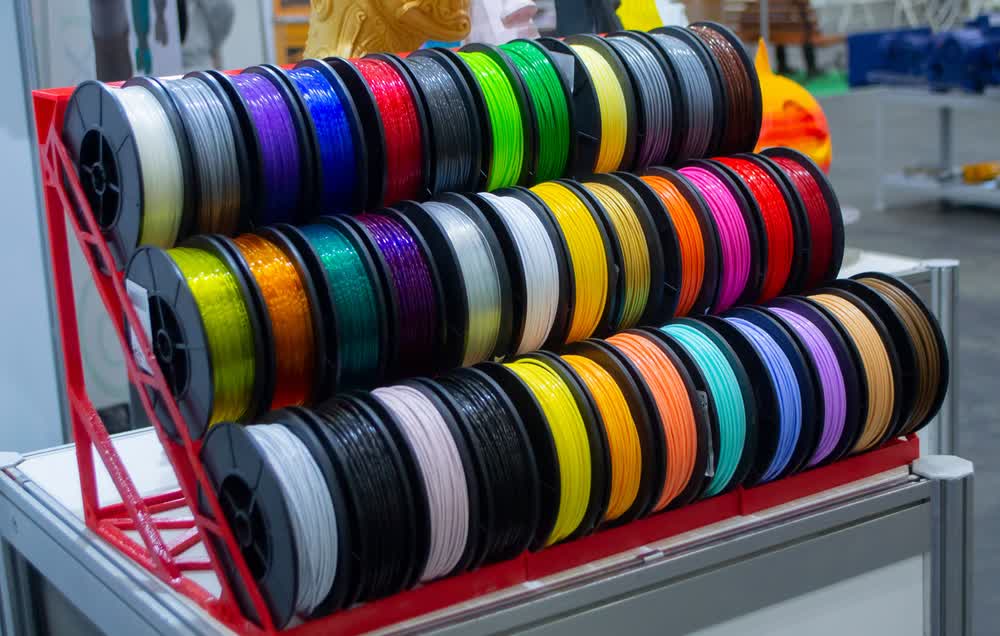
A comprehensive guide to 3D printing materials and their properties
Share
Choosing the right 3D printing material depends on what you want to print – decorative objects, functional parts, prototypes or industrial components. This comprehensive guide introduces the most common and specialized filaments, their temperature ranges, mechanical properties, drying requirements and applications. It also includes the Heat Deflection Temperature ( HDT @ 0.45 MPa ), which tells you at what temperature a material starts to soften under load.
📊 Table: Most common 3D printing materials and printing settings
| Material | Nozzle temperature (°C) | Bed temperature (°C) | Chamber temperature (°C) | Drying requirement | HDT @ 0.45 MPa (°C) | Applications |
|---|---|---|---|---|---|---|
| PLA | 190–220 | 50–60 | Not necessary | Low | ~55 | Decorations, prototypes, non-heat-resistant parts |
| PLA+ / Tough PLA | 200–220 | 50–60 | Not necessary | Low | ~60 | Strong but easy parts – fasteners, toys |
| PETG | 230–250 | 70–85 | Not necessary | Moderate | ~75 | Practical parts, bottles, cases, covers |
| ABS | 240–260 | 90–110 | 60–80 | High | ~95 | Durable, heat-resistant housings and mechanical parts |
| ASA | 240–260 | 90–110 | 60–80 | High | ~98 | UV-resistant parts, outdoor use, automotive parts |
| TPU/TPE | 210–240 | 40–60 | Not necessary | Moderate | ~60 | Flexible parts, seals, shock absorbers |
| Nylon (PA6, PA12) | 250–280 | 70–100 | 60–90 | Very high | ~75–90 | Strong, wear-resistant mechanical parts |
| Nylon CF/GF | 250–290 | 80–110 | 70–90 | Very high | ~110 | Fiber-reinforced, lightweight yet strong components |
| PC (Polycarbonate) | 260–310 | 100–130 | 90–110 | High | ~120 | Heat-resistant shields, mechanical parts, lamps |
| PBT | 250–270 | 80–110 | 70–90 | High | ~120 | Electrical connectors, gear housings, technical parts |
| PPS (Polyphenylene sulfide) | 300–330 | 120–140 | 100+ | High | ~230 | Industrial applications, high heat and chemical resistance |
| PEEK | 360–400 | 120–150 | 120+ | High | ~250 | Aerospace, medical implants, heavy industry |
| PEI / ULTEM | 340–380 | 120–150 | 120+ | High | ~210 | Electrical insulators, industrial structural parts |
| HIPS | 230–250 | 90–110 | 60–80 | High | ~90 | Support material for ABS, also lightweight prototypes |
| PP (Polypropylene) | 210–240 | 80–100 | 50–70 | High | ~95 | Lightweight, flexible parts, containers, hinges |
| PVA | 190–220 | 60–70 | Not necessary | High | ~45 | Water-soluble support material for multi-material printing |
| PET-CF / PET-GF | 250–270 | 80–100 | 60–80 | High | ~120 | Highly rigid, durable mechanical parts |
| PAHT-CF (High Temp Nylon Carbon Fiber) | 270–290 | 90–110 | 80–100 | Very high | ~150 | Automotive, industrial parts, metal substitute |
💡 Examples of uses
- PLA & PLA+ → Easy to print: decorative items, modeling, prototypes, school projects.
- PETG → Excellent for home use items: brackets, boxes, water bottle holders
- ABS / ASA → For parts that are resistant to heavy wear and heat: RC car bodies, electronics housings, outdoor parts.
- TPU / TPE → For flexible parts: seals, footwear parts, protectors, phone cases.
- Nylon / Nylon CF → For industrial-grade parts: gears, hinge shafts, durability parts.
- PC → For mechanical and heat-resistant parts: machine guards, lampshades, covers.
- PPS, PEEK, PEI → For demanding professional applications: electrical connectors, industrial parts, etc.
- PVA & HIPS → As support materials when printing with dual nozzles.
💨 Filament drying
Humidity is one of the most common problems in 3D printing. When filament absorbs water from the air, it bubbles up in the hot nozzle, leading to poor surface quality and weak parts.
| Material | Drying temperature (°C) | Drying time (h) |
|---|---|---|
| PLA | 45–50 | 2–4 |
| PETG | 60 | 4–6 |
| ABS / ASA | 80 | 4–6 |
| TPU | 50 | 6–8 |
| Nylon | 75 | 8–12 |
| PC | 90 | 6–8 |
| PEEK / PEI | 120 | 6–10 |
For drying, you can use a filament dryer, oven, or a closed printing chamber with heat and ventilation.
⚙️ Fiber-reinforced filaments
Fiber-reinforced filaments, such as carbon fiber (CF) and glass fiber-filled (GF) materials, offer greater stiffness and durability than standard plastics. They are also less prone to warping or shrinkage, making them stable and reliable parts , even at lower chamber temperatures than conventional filament types.
These materials are often used in industry and hobby projects where durable and dimensionally accurate parts are needed, such as:
- drone bodies
- tool holders
- mechanical support structures
- camera mounts and racing discs
Things to note when printing:
- Use a nozzle made of hardened steel or tungsten carbide , which can withstand temperatures up to 450°C.
- Filament should always be dried before printing , as moisture can weaken the mechanical properties of fiber-reinforced materials.
- A high-quality hotend and good substrate adhesion are recommended to achieve the best print quality.
Fiber-reinforced filaments thus provide stability, rigidity, and precision for demanding 3D printing applications.
🔍 Summary
- For beginners: PLA, PLA+, PETG
- For consumer goods: PETG, ABS and ASA
- For industrial parts: Nylon CF, PC, PPS
- For extreme conditions: PEEK, PEI
- For flexible applications: TPU
- Support materials: PVA, HIPS
The right material, good drying and a high-quality hotend form the foundation for successful and sustainable 3D printing.
